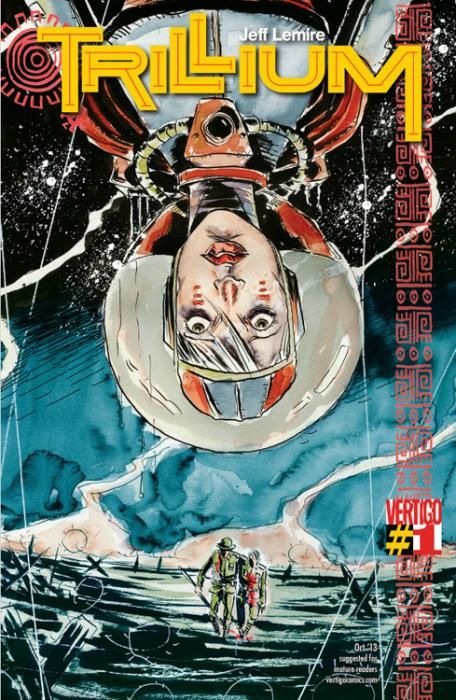Jeff Lemire's mini-series "Trillium" from Vertigo is a strong, if not perfect, start with a killer hook. Lemire's almost-one-man show (Jose Villarrubia assists on colors and Carlos M. Mangual on letters) falters in places, but the concept alone makes it worth a read.
The mystery at the center of "Trillium" and the way Lemire chooses to unfold it are certainly the main strengths of the book. Lemire opts to tell the story from two wildly different perspectives and connects them in the middle, so that a cliffhanger occurring in the middle of the book makes a delicious kind of sense only when arriving to the same ending again (at the true end) but with the other half of the story opening now in place.
The story opens with an almost unrecognizable (very distant but non-specific) future for mankind in which our heroine Nika is running out of time to save the 4,000 remaining humans in the universe from a sentient disease. The disease is evolving as if determined to kill every human left, and Nika's only hope are the natives and a mysterious flower on the planet where Nika's science lab is located. Nika on the other side of mysterious temple to find a world utterly unlike the one she has come from, and face to face with a man on the run in a jungle.
Jumping off from that cliffhanger, the other story track focuses on William, a PTSD war veteran on an obsessive mission to find the Lost Temple of the Incas. More specifically, he's running for his life from an Amazon tribe that has killed his search party. This side of the story is less compelling than Nika's, if only because it's a bit heavy handed with the war flashbacks. Plus, readers don't yet understand why William is so obsessed with the temple, while Nika's obsession is easy to understand: keep the human race from dying out. Still, Lemire handles even the cliched stuff well, and he's set out a lot of great questions to be answered on both sides.
Lemire's loose, unpolished illustration style both works to his advantage in Trillium and holds him back. The expressive quality of his work, especially when it comes to setting tone, character expression and movement on the page is lovely and terribly enjoyable. However, there are places where the art feels too thin and almost -- inaccurate. What should feel epic and precise -- an ancient temple -- instead feels rushed and ill-considered. A line while in the jungle -- "I didn't think the underbrush could get any thicker" -- is bizarre because that's just not what the visuals portray. While something simple like this still feels like a mistake when there is a team of people on a book, it's all the more egregious when the writer is also the artist. The "future" part of the book is far more interesting and believable than the "real world/past" part of the book, if only because Lemire seems to let his creativity go wild and there's more room for him to cut loose. In the "accurate" jungle and war scenes, the thin bits and glossing over of real details just feels under researched, or like it simply doesn't play to Lemire's strengths.
Still, weaknesses aside, the concept on its own is fascinating, and I'd be shocked if most readers weren't salivating to read the next chapter to see what Lemire has up his sleeve. With a critical eye it's impossible to not see some of the seams in the work, but from a pure enjoyment standpoint I found myself incredibly fond of what I read and excited to get my hands on what comes next.

